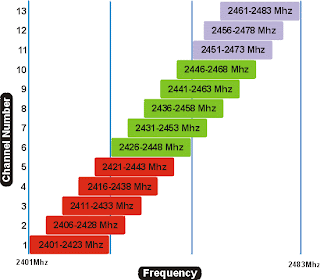Go to Advice start page
More WiFi Bandwidth? Not This Year
If you have a network of computers, you're probably connected by Ethernet in some portion of the network, so you're used to the Ethernet 100M (or newer 1G) bandwidth. You like the freedom of WiFi, but freedom comes at a cost - loss of bandwidth. The current WiFi standard 802.11g has a maximum bandwidth of 54M (and I should emphasise maximum, here).
So the WiFi manufacturers are trying to satisfy your need for high bandwidth, and they came up with a couple solutions, which will have a maximum bandwidth of 108M. The new standard includes 2 features (using names which vary by vendor):
MIMO, or Multiple-input Multiple-output, uses multiple radios and antennas. MIMO has two components.
- Antenna diversity. If you're familiar with FM radio in your car, and multi-path interference, you'll know the value of antenna diversity. The idea behind antenna diversity is that, if the signal from a radio transmitter is weak on one antenna, because of MPI, it will, hopefully, be stronger on another antenna some distance away from the first. A special processor does nothing but compare the signal being received by two different antennas, and select the stronger.
- Beamforming. Antenna diversity counter acts multi-path interference. Beamforming uses the principle of multi-path interference, at the transmitter, to focus the strength of the transmitted signal in one direction. Using the diversity antennas on a MIMO component, it's possible to identify the relative location of the other device in communication; using beamforming, the transmitted signal is focused in that direction.
- By combining antenna diversity and beamforming, it's possible to extend the effective range of a WiFi conversation. You can locate the router / access point, and the client computer(s), at a greater distance from each other, and yet get acceptable performance.
With 108M, aka Super-G, there is one channel - "6".

WiFi Channels 1
Are you curious about how many WiFi channels actually exist?
Both MIMO and Super-G will give you more bandwidth, and more effective range, assuming that you have no neighbours with WiFi. If you have neighbours (and who doesn't), only one of you can use a channel at any given time. Your equipment will have to decide how to share the channel. But, there are additional issues here.
- MIMO will increase the effective size (area) of your WiFi neighbourhood, by increasing the effective distance between WiFi components that can detect each others signals. This increases the number of devices that have to share the channel, at any time.
- Super-G will increase the size (volume) of your WiFi neighbourhood, by using more of the frequency spectrum to create more bandwidth. More channels used by your WiFi router increases the number of devices that have to share the channel, at any time.
- More devices that have to share the channel means less time each device can transmit, and less bandwidth available to each client device. More devices that have to share the channel means more possibility of collisions, at any time, and again, less bandwidth available to each client device.
- Neither MIMO nor Super-G are part of any ratified standards. You can't predict, with any reliability, how well equipment from different vendors will interact with each other. This will affect performance on your LAN, and between your LAN and your neighbours LAN. Check out ExtremeTech: Real-World Interoperability Tests of Five 802.11n Routers for a good discussion of this issue, with actual hardware testing results.
The dynamic effect of MIMO beamforming may have another effect. When you setup a WiFi LAN, you're advised to try different channels (most objectively, using NetStumbler or a similar site survey tool). Over some period of time, you should be able to identify the majority of your WiFi neighbours, and pick a less congested channel.
With a WiFi router that uses beamforming, you'll have a dynamic signal pattern, which will change as a WiFi client is moved around the house. There will be a constantly changing visibility of WiFi neighbours, on any given channel (or group of channels). This will cause problems similar to the WiFi hidden node problem. Some victims of a neighbour using beamforming may see this as "channel hopping", as a neighbouring network will come and go, repeatedly, on the channel.
In short, neither MIMO nor Super-G are products which will be useful in neighborhoods of any density.
For more information, and discussions pro and con, see
▲ Top

